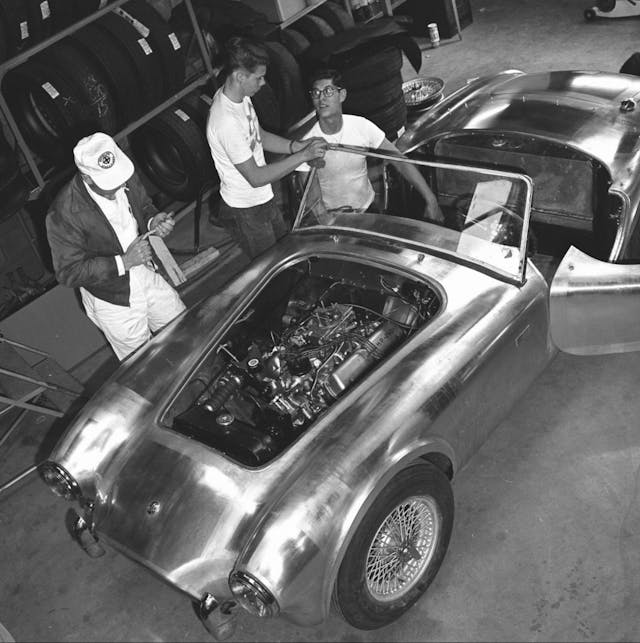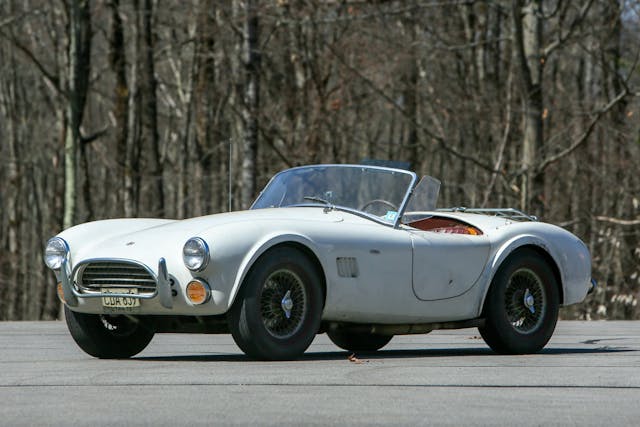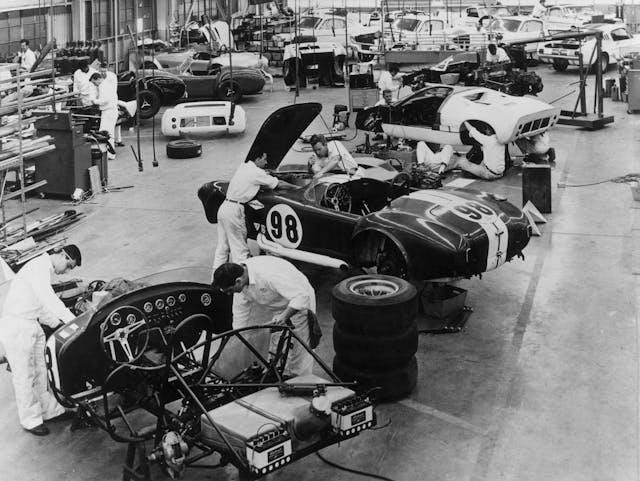The story of the Shelby Cobra in 5 cars
At a time when engine swaps were reserved for hot rodders and outlaws, Carroll Shelby bolted a V-8 into a little British car and created a ’60s icon. A lot of us know the basics of the Cobra’s story but rather than rehash the same few talking points, we picked five cars that tell the brief, fascinating history of the Shelby Cobra.
The original

The idea for the Cobra was not that crazy: Take the lithe, simple AC Ace and tuck a V-8 under the hood. Choosing which engine came down to Shelby’s business sense and Chevrolet’s lack of interest in supporting the project. The final choice—a Ford—was likely an easier fit considering the distributor location, but Shelby and his team were problem solvers who could have easily found a work-around, had they preferred the Chevy mill.
While many think Shelby made only two versions of the Cobra—those powered by a 289-cubic-inch V-8 and those by a 427-cubic-inch V-8—the reality is more nuanced. The first cars were fitted with 260-cubic-inch Ford V-8s backed by Borg Warner four-speed manual transmissions. Starting with chassis code CSX2000 in 1962, the first 75 cars got the smaller-displacement V-8. Each of the remaining 51 early-production cars got a larger, 289 cubic-inch engine.
The driver’s choice

The slight increase in engine displacement was a great choice, and it created what Cobra aficionados say is the best car if you really want to drive. Look no further than The Barn Find Hunter himself, Tom Cotter, who has racked up hundreds of thousands of miles in his 289-powered car.
The 289 was also a force to be reckoned with on the racetrack. They were routinely hassling Ferraris and taking lunch money from Corvettes. On track the cars had a balance—if you can call an overpowered British roadster balanced at all—that allowed drivers to shine. Sadly, those racers were shining from sweat due to their car’s lack of a roof. That problem brought in Peter Brock and his team, who together created …
The specialist

Brock and his team were less worried about sunburns on drivers’ necks than the aerodynamic disadvantages of the roofless design. Even as the Ford 390 V-8s were finding their way into Mark II Cobras, the aerodynamic drag of the car’s body was limiting the Cobra’s performance in a straight line. The result of the project was the Daytona Coupe, which added a roof and Kamm-back rear to create the first enclosed Cobra in 1964.
The Daytona name came from one of the tracks where this new roofed car won. Daytona Coupes also won at Le Mans, Sebring, Monza, and set endurance speed records, proving the combination of aero and power created a formidable race car. The shape of the Daytona coupe even solved the high-speed stability issues of the roadster. Aerodynamics, however, were not Carroll Shelby’s thing. He liked horsepower, and he returned to the roadster shape to create …
The icon

Say “427” in the right crowd, and everyone collectively says “Cobra.” It’s a Shelby fan’s version of Marco Polo. The Mark III was the product of Ford, AC, and Shelby working together to create a car that fit the design brief from Shelby and debuted in 1965. Much of the hardware on the earlier cars was turned up to 11 in order to fit the 427 side-oiler big-block Ford, an engine that had impressed Shelby in racing versions of the Ford Galaxie.
Spotting a 427 Cobra is easy compared to the earlier cars: The radiator opening is larger, as are the fender flares, which were enlarged to fit new wheels and tires. Underneath, the tubing comprising the frame increased in diameter, from 3 inches to 4. The traverse leaf springs in the suspension disappeared in favor of coil springs at all four corners. There were two versions of the 427 available: The standard ones that sported 425 hp and the competition cars that put out a ground-pounding 485 hp. That wasn’t enough power for Shelby, though, and his lust for more created the final form of the Cobra.
The absurd

It’s difficult to take something that is already over the top and make it wilder, but Shelby used a competition Cobra to do exactly that, usability be damned. The list of what makes a car streetable is short to a guy like Shelby: mufflers, chrome bumpers, and a windshield. Oh, and two Paxton superchargers, a subtle little upgrade. The rumor mill says 800 hp was churning under the hood of the “Super Snake,” and that the cars were nearly undriveable, even when fitted with an automatic transmission. Only two were created. Only one, chassis CSX3015, lives today; the other was driven over a cliff and into the Pacific Ocean.
Is that the entire history of this unique American sports car? Not hardly, but this list should give you an idea of why the Cobra became and has stayed an icon of the car world—possibly the most duplicated or copied car of all time and a dream for many enthusiasts. The Cobra stands as a car that could only have been born when it was. Something like it will likely never happen again—no matter how run-of-the-mill an engine swap has become.
***
Check out the Hagerty Media homepage so you don’t miss a single story, or better yet, bookmark it. To get our best stories delivered right to your inbox, subscribe to our newsletters.



The day I won Carroll Shelby’s NAJA Driving Championship, we sat together at dinner. Here’s what he said when I asked him which he thought was better…the Big Block or Small Block Cobra:
“The big block was a BASTARD of a car! Go like hell in a straight line, but that’s about it…the small block was a MUCH better car.”
I said, “Thought so.”
Here’s a shot of me with him saying “It’s been a long time since I’ve seen someone handle a car like that!” I was a few thousandths of a second behind going into the final run. So, I had nothing to lose by driving the car at 11/10ths!
https://www.steeringwheelguy.com/about.html
“the other was driven over a cliff and into the Pacific Ocean.”
Ummm, where?! Was it recovered and what is that story?
From the “hotcars” website – “Shelby American sold the car to a dealer, a gentleman named Tony Maxey bought it, but he was fatally injured when his throttle got stuck, and he rolled out of a cliff and into the Pacific. The wreckage was brought to the U.K. for restoration and the CSX 3303 is now a part of a private collection.”
It is amazing how every Ford story out of Hagerty begins or ends with should have been a Chevy.
To George Patterson. I owned a 1965 Ford Falcon, with an optional 289 Hi-Po (271 hp, solid lifters ) , 4 speed.
When the Cobra came out I was working for TWA in San Francisco. We use to fly them back east to their new owners. The way you load items on a plane is a special large solid pallet like sheet that is moved on rollers. Moving it requires you to push on the item being transported. After the first car arrived at it’s destination all dented, from pushing on the aluminum body. the procedure changed and push supports were added.
I just got back from a spin in my FFR M2 w/a built 302 when I spotted this article. I have wanted one since my older brother Bill told me about them 46 years ago. He taught me all about mechanics. He has passed but I think of him whenever I work on it or drive it. In my second season now. What a blast!!
Hmmmmm…..never been and never will be…. ?
Regarding first never: two words: Dodge Viper.
The Super Snake was totally disassembled and modified after it was sold by Shelby, then eventually put back together though not quite the same. Different shifter, manifold, different superchargers and it got painted a nicer darker blue from the original pale metallic blue. I had heard that the Bill Cosby car that went off the cliff was to be restored and offered in auction but something happened. All they need is a few parts with VIN numbers and cars get recreated. I’m sure the remains were dragged back to the road on Hwy 1.
The second one, that was driven off the cliff into the Pacific Ocean? Well, turns out, it was found!!!! That monster has been removed and is supposedly undergoing a restoration. I read that just a couple years ago. Now, exactly how true that is, remains to be seen. By the way, the Cobra that was driven into the ocean, was the one given to Bill Cosby and that he found TOO powerful.
In ’65 or ’66 there was at least one Cobra in the showroom of Koons Ford (7 Corners) Falls Church, VA with the window sticker and placard that indicated it was a 428 CI motor. I don’t recall ever seeing a story that confirmed or acknowledge such a combo. As for it being a Cobra Jet engine, I believe that engine first appeared in 1968 in the Mustang. Anyone out there able to shed further “Light” on this matter?
When I was a young man, I had a ’59 Austin Healy 100-6. I loved that car, as beat up and corroded as it was. I remember reading about an engine swap, might have been a kit, that would put a 289 in it to replace the inline 6 it came with. It turns out the 289 was much lighter than the 6, and in order to handle “properly” the engine compartment had to find room for the needed extra weight. I would imagine that the AC had a four cylinder engine, and the weight differential was minimal. Back then, even in my small New England town people were doing all kinds of crazy things involving junk yard donors. A great time to be alive as I recall it…
What is missing is the FACT that Shelby stole the idea for a V-8 powered AC Bristol from Roger Wing, the father of a friend of mine, who had dropped a Corvette engine in his AC and was drag racing it at Upper Marlboro, MD. Shelby saw it, and a year later sold the idea to Ford. Never gave Roger Wing credit, much less any cash…
Like he was the only one to put a big motor in a small car.
A question for a real Shelby expert. I remember one small block Cobra was fitted with a 390 CI engine (I believe Miles hit something with it in a race). But I also recall hearing the 390 was not the same engine used in TBirds and full sized Fords for years. Anyone have accurate data on this?
The Daytona did NOT win at Daytona. The name was an accident of Shelby PR calling it that BEFORE the race.
Second the handling of the 427 was due to the insistence by AC to utilize 90 tubes for the 427 instead of the 93 inch tubes called for by the Ford suspension designer.